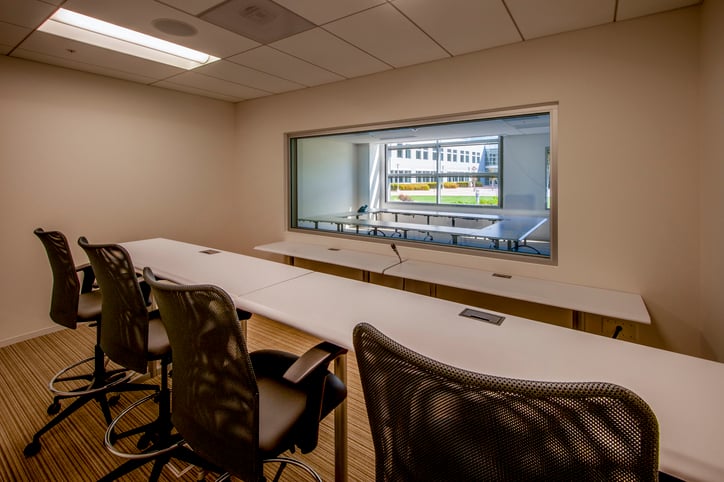
In the realm of optical illusions, few inventions capture our imagination quite like one-way mirror glass, creating mirrors that aren’t just “mirrors,” they’re also “windows.”
This material has the ability to seemingly defy the laws of reflection and light transmission, allowing observers on one side to see through while appearing as a mirror to those on the other.
From high-security interrogation rooms to engaging art displays, the applications of one-way mirrors are diverse and intriguing.
So what is one-way mirror glass? Let’s look into how it’s made, its commercial applications, and best practices to maximize its effectiveness.
How Do One-Way Mirrors Work?
A one-way mirror, sometimes also called a two-way mirror or half-silvered mirror, appears as a mirror from one side while allowing light to pass through from the other side, allowing observers on the reflective side to see through the glass, while those on the transparent side only see their own reflection.
These mirrors are made by depositing a microscopically thin layer of metal, typically aluminum or silver, onto a transparent substrate, such as glass. This metal coating allows partial reflection and partial transmission of light, resulting in the desired effect.
Keep in mind, one-way mirror glass must be installed with the coating on the subject’s (observed person) side to create a visual barrier between subjects and observers.
One-Way Mirror Applications
One-way mirrors find diverse applications across various industries. Here are a few examples:
- Law enforcement and interrogation rooms
- Security and surveillance
- Hospitals and care facilities
- Entertainment and exhibitions
Law Enforcement and Interrogation Rooms
They allow law enforcement officers to observe suspects discreetly without being detected, enabling the collection of crucial evidence.
Security and Surveillance
In surveillance setups, they’re employed to discreetly monitor public areas. Banks, casinos, retail stores, and airports often use them for efficient and inconspicuous surveillance.
Hospitals and Care Facilities
Striking a balance between privacy, observation, and care, one-way mirrors help medical professionals provide effective treatment, monitoring, and support while respecting the dignity and confidentiality of patients. This improves patient outcomes and creates a better overall healthcare experience.
Entertainment and Exhibitions
In the world of theater and magic shows, one-way mirrors create illusionary effects, contributing to captivating performances. Similarly, museums and exhibitions use them to create interactive displays and engage visitors in unique ways.
|
New Angle Beveling proudly distributes Pilkington Mirropane™ – the ideal choice for supermarkets, computer rooms, banks, and cash offices, where areas need to be kept under observation or hidden from public scrutiny. |
Achieving Maximum Effectiveness
Before installing one-way mirror glass, consider the following to achieve your piece’s maximum effectiveness:
- Light the reflective side
- Keep the transparent side dimly lit
- Observation angle and distance matter
Lighting the Reflective Side
Maintaining a stark contrast in lighting between the reflective side and the transparent side enhances the effectiveness of one-way mirrors. Make sure the reflective side is significantly brighter than the transparent side.
However, as you’re lighting the reflective side, you need to avoid directly lighting the glass, which could negate the mirror effect of the coated side.
Overall, a good lighting ratio to aim for is 8:1.
Keep the Transparent Side Dimly Lit
To minimize the visibility of the transparent side, keep it dimly lit with lighting directed away from the glass. This creates a distinct contrast between the reflective side and the transparent side.
The room’s color palette should be darker, nonreflective, and uniform, including walls, furnishings, and even the observers’ clothing.
Observation Angle and Distance Matter
The angle at which the observer views the mirror affects its transparency. The reflective side appears darker when viewed from a steeper angle. Consequently, positioning the observer at a slight angle increases the effectiveness of the one-way mirror.
How One-Way Mirrors Are Made
There are two ways to manufacture one-way mirror glass:
- On-line pyrolytic coating
- Sputter coating after production
1. On-line Pyrolytic Coating
While most glass coatings are applied post-production, pyrolytic coating, aka hard coat, is applied while float glass is still in a semi-molten stage. Through chemical vapor deposition, the coating is chemically bonded to the glass at the molecular level.
The resulting coat is extremely durable and stable because it’s infused into the surface of the glass.
2. Sputter Coating After Production
These coatings, often called "soft coats," are applied after float glass has cooled. They’re susceptible to scratching and deterioration over time, necessitating careful handling.
Soft coat glass has limitations such as limited shelf life, inability to undergo heat treatment after coating, and the need for edge deletion during insulating glass fabrication. These factors increase processing costs and lead times.
One-Way Mirror Glass: Additional Fabrication
Provided you choose one-way mirror glass with pyrolytic coating, such as Pilkington Mirropane, additional fabrication can be done on your pieces, such as:
- Tempering
- Cutting/shaping
- Lamination
- Insulation
- Heat strengthening
In the case of soft-coated pieces, their fabrication needs to be processed before they can be coated, increasing lead and production times.
Reflecting on One-Way Mirror Glass
One-way mirrors continue to captivate our imaginations with their unique ability to provide observation and privacy simultaneously. From crime investigations to theatrical performances, their applications are diverse and far-reaching.
Understanding their scientific principles, best practices, and manufacturing process helps us appreciate the ingenuity and uses of these unique glass pieces.
Need More Information?
We’re always glad to help provide more information on our products, such as one-way mirror glass. Contact us with your questions:



